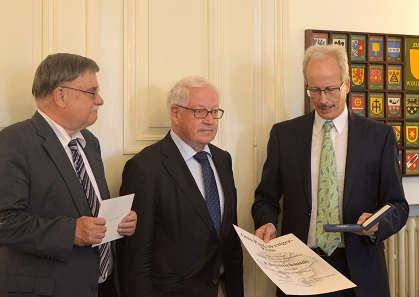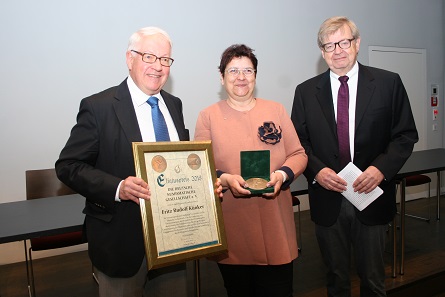July 5, 2018 – On May 5, 2018, the president of the Deutsche Numismatische Gesellschaft (German Numismatic Society) Dr. Barbara Simon presented Fritz Rudolf Künker with the Eligius Award. On June 28, 2018, the Verband Schweizerischer Berufsnumismatiker followed. They honored Künker with the Otto Paul Wenger Award.
The outgoing VSBN President Marcel Häberling presenting the Otto Paul Wenger Award to Fritz Rudolf Künker. On the left the outgoing VSBN Secretary General Lutz Neumann.
Fritz Rudolf Künker undoubtedly deserves both of these awards reflecting his commitment to the world of numismatics. He has repeatedly advocated the cooperation of dealers, collectors, scholars, and museums. And that’s not all there is to him. His outstanding French skills allowed him to work as a mediator between German and French coin dealers. He was a link between Paris and the IAPN. Fritz Rudolf Künker is one of the great unifying figures of numismatics. With his dedication, enthusiasm, and integrity he can prove to any politician why collecting and trading coins and medals is an essential part of European cultural life.
From a small coin collector to an international auction house
Fritz Rudolf Künker was fascinated by numismatics at an early age already. A Saxon Five-mark coin from 1903 sparked his interest and thus he began a collection of coins of the German Empire as a secondary school student.
Peter Berghaus, who taught at the University of Münster at the time, became Künker’s numismatic mentor. Berghaus’s lectures were inspiring to many of the most renowned German numismatists. Although Künker was studying history and Romance studies – first in Berlin in 1967 before he transferred to Münster in 1969 – he nevertheless attended Berghaus’s lectures and read up on the academic aspects of numismatics.
It was around the same time that Fritz Rudolf Künker opened his own coin store in the small village of Schapdetten close to Münster in 1971. It was a one-man business in his student shack; his own collection served as seed money.
Thus, he took the chance he was given as collecting coins became a mass phenomenon in the 70s. On August 15, 1971, President Richard Nixon directed to suspend the convertibility of the dollar into gold, which resulted in a fear of inflation in Germany as well and consequently increased the demand of investments assets. Month after month more people were interested in coins and precious metals. Therefore Fritz Rudolf Künker could hire his brother Horst-Rüdiger Künker as his first employee in charge of gold trade. With K1 and K2, as the brothers are referred to in-house, the story of a business began that would develop into the largest numismatic auction house in Europe.
The first small store was opened in Osnabrück in 1973. Although the numismatic scene preferred Munich or Zurich, Fritz Rudolf Künker remained faithful to Osnabrück throughout all these years of success. In 1985 the company moved to a Gründerzeit style villa within the city. It was vacated in May of 2014 in favor of a new building that had been constructed for the auction house.
Nowadays the Künker company has more than 50 employees and branch offices or representatives in Munich, Berlin, Hamburg, Znojmo, and Zurich.
Fritz Rudolf Künker was never someone who did not know how to delegate work. Along with the move to the new headquarters, he stated that from July 1, 2014 on the sole management would be in the hands of his son Ulrich Künker and Dr. Andreas Kaiser.
Fritz Rudolf Künker holding the Eligius Award 2018. From left to right: Fritz Rudolf Künker, Dr. Barbara Simon (President of the German Numismatic Association), Albert Raff (Chairman of the jury who is in charge of the award ceremony). Picture: DNG.
Commitment to the collector
The cooperation of all branches of numismatics was always at the center of attention for Fritz Rudolf Künker. His conciliatory nature and resentment to hatred made him a central figure in the world of numismatics. As he cultivated contacts even in politics he was able to quietly exert his influence in the name of numismatics. One of his biggest successes was probably the peaceful settlement of a dispute regarding the Horn collection which ended with a win for all those involved: Through selling said collection the Otto-und-Emma-Horn-Stiftung finally obtained the funds they desperately needed, thanks to generous donations the Numismatic Cabinet of Dresden acquired those coins from the collection that their own collection was missing, and other collectors could purchase the remaining coins of excellent provenance. The Sächsische Numismatische Gesellschaft awarded Künker for this accomplishment in June of 2015. His involvement in the restitution of the Gotha collection also came up in this context.
It is less known that Fritz Rudolf Künker was one of the first coin dealers who presented both collection and their collectors as one unit in his auction catalogs. Names such as Karl Witte (Auction 3), Egon Beckenbauer (Auction 7), Dr. med. Georg Stalling (Auction 15), and Gerhart Rother (Auction 189) are just a few names who are representative of all those collectors who put their trust in Künker to sell their collections.
One of the cornerstones of his success was certainly the sense of deep respect that he showed concerning the life’s work of a collector. A great number of collectors were memorialized in his auction catalogs.
The fight against counterfeiters and counterfeits
In 1972 Fritz Rudolf Künker joined the Verband der deutschen Münzenhändler (The Association of German Coin Dealers). Five years later he was elected chairman and he held office from 1977 until 1986. The International Association of Professional Numismatists (IAPN) admitted him in 1983. After Silvia Hurter had left office he took over the management of the IBSCC alongside Alain Poinsignon. As the most important member of the committee, he promoted the use of the latest scientific techniques to add to the traditional methods of detecting counterfeits.
His greatest achievement was probably the role he played in the exposure of the coin counterfeiter Otto Wetzlaff in 1993, who was then convicted of fraud.
It should also be mentioned briefly that Künker was the IAPN’s treasurer for many years, which is indicative of the trust he enjoys from his colleagues.
Other awards
These two awards Fritz Rudolf Künker has been granted in 2018 are not the first ones he has received. He is a Vreneli laureate and has won the internationally renowned World Money Fair Award. Künker is at home in the world but he is the pride of Osnabrück, which is why he is an honorary member of the local Verein der Münzfreunde für Westfalen und Nachbargebiete.
The German Numismatic Association’s Eligius Award
Every year the Eligius Award is granted to someone who has made an outstanding contribution to numismatics. Laureates include Peter Berghaus (2004), Hans-Jörg Kellner (2005), and Wolfgang Steguweit (2015).
The VSBN’s Otto Paul Wenger Award
The Verein Schweizer Berufsnumismatiker established the Otto Paul Wenger Award in 1982 in memory of their founding member Otto Paul Wenger, chairman of the numismatic department of the Schweizerische Kreditanstalt (now: Credit Suisse) in Bern. Throughout his whole life, Wenger worked on opening up numismatics to a wider audience and to spark young people’s interest in collecting coins through popular scientific publications. Laureates include Leo Mildenberg (1994), Herbert Cahn (1995), Edwin Tobler (1982), Hubert Emmerig (2011), Dieter Raab (2014), and Albert M. Beck (1989).
For further information on Fritz Rudolf Künker please consult our Numismatic Who’s who.
On the Eligius Award and previous awardees you can check the DNG website (in German only).
A (German) Wikipedia article is dedicated to the Otto Paul Wenger Award.






